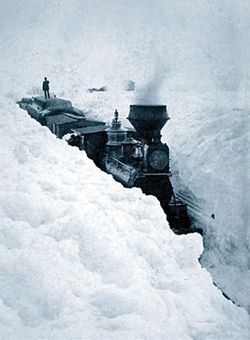Blizzard: Difference between revisions
No edit summary |
|||
| Line 24: | Line 24: | ||
One-hundred five years to the day (March 12) after the blizzard of 1888, a massive blizzard, nicknamed the [[1993 North American Storm Complex|Storm of the Century]], hit the U.S in 1993. It dropped snow over 26 states and reached as far north as [[Canada]] and as far south as [[Mexico]]. In many southern U.S. areas, such as parts of [[Alabama]], more snow fell in this storm than ever fell in an entire winter. Highways and airports were closed across the U.S. As a wider effect, the storm spawned 15 [[tornado]]es in [[Florida]]. When the Storm of the Century was over, it affected at least half the of U.S. population; 270 people died and 48 were reported missing at sea. |
One-hundred five years to the day (March 12) after the blizzard of 1888, a massive blizzard, nicknamed the [[1993 North American Storm Complex|Storm of the Century]], hit the U.S in 1993. It dropped snow over 26 states and reached as far north as [[Canada]] and as far south as [[Mexico]]. In many southern U.S. areas, such as parts of [[Alabama]], more snow fell in this storm than ever fell in an entire winter. Highways and airports were closed across the U.S. As a wider effect, the storm spawned 15 [[tornado]]es in [[Florida]]. When the Storm of the Century was over, it affected at least half the of U.S. population; 270 people died and 48 were reported missing at sea. |
||
Blizzards are very very cold and can on happen if the temperature is 35 degrees F or lower. |
|||
==Requirements for a Blizzard== |
==Requirements for a Blizzard== |
||
Revision as of 19:29, 19 October 2006


Blizzard: a severe winter storm condition characterized by low temperatures, strong winds, and heavy blowing snow. They are formed when a high pressure system, also known as a ridge interacts with a low pressure system, this results in the advection of air from the high pressure zone into the low pressure area. The strength of the high and depth of the low will determine indirectly how strong winds between the systems will be based upon the pressure gradient between. The term blizzard is often misused by the media to describe a large winter storm which may or may not contain strong winds and often will not meet official blizzard criteria as defined by the local weather agency or governing body.
Etymology
The word blizzard is of unknown origin, but may originate from the surname Blizzard. It was first widely used after the great United States winter storm, now known as the "Blizzard of 1880."
Climatology
Severe blizzards can occur in conjunction with polar cyclones.
Most blizards that cause much damage happen in the colder enviroments including the north of the US and much of Canada.
Certain types of blizzards in the northeastern United States are colloquially known as Nor'easters. In the Upper Midwest, a northerly weather pattern deemed likely to produce blizzards is called an Alberta clipper.
Famous U.S. Blizzards
There have been many devastating blizzards throughout U.S. History.
It is not uncommon for a region of the United States or North America to be struck by two devastating winter storms in one season. The Great Blizzard of 1888 paralyzed the Northeastern United States. In that blizzard, 400 people were killed, 200 ships were sunk, and snowdrifts towered 15 to 50 feet high. Earlier that year, the Great Plains states were struck by the Schoolhouse Blizzard that left children trapped in schoolhouses and killed 235 people.
These unpredictable storms can come without much warning, causing damage and destruction to humans and infrastructure. The Armistice Day Blizzard in 1940 caught many people off guard with its rapid and extreme temperature change. It was 60 degrees Fahrenheit in the morning, but by noon, it was snowing heavily. Some of those caught unprepared died by freezing to death in the snow and some while trapped in their cars. Altogether, 154 people died in the Armistice Day Blizzard.
One-hundred five years to the day (March 12) after the blizzard of 1888, a massive blizzard, nicknamed the Storm of the Century, hit the U.S in 1993. It dropped snow over 26 states and reached as far north as Canada and as far south as Mexico. In many southern U.S. areas, such as parts of Alabama, more snow fell in this storm than ever fell in an entire winter. Highways and airports were closed across the U.S. As a wider effect, the storm spawned 15 tornadoes in Florida. When the Storm of the Century was over, it affected at least half the of U.S. population; 270 people died and 48 were reported missing at sea.
Blizzards are very very cold and can on happen if the temperature is 35 degrees F or lower.
Requirements for a Blizzard
For a "blizzard" to be classified as a blizzard it has to have these things:
1.Falling snow 2.56mph+ winds 3.Low temp. 4.Etc.(eccetera)
See also
External links
- Natural Disasters – Blizzards Great research site for kids.
- Dr Richard Wild – Heavy Snow, Blizzards, Snowstorms and Snowfall Site Online home of Dr Richard Wild. Site includes history and news of heavy snow, blizzards, snowstorms, snow pictures, snow data and other historical snowfalls and blizzard related topics.
- Digital Snow Museum Photos of historic blizzards and snowstorms.
- Blizzards Photo Gallery Photos of huge U.S. snowstorms, plus blizzard survival info — all from AOL Research & Learn
